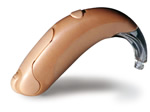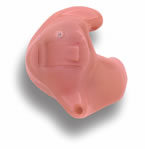Types of Hearing Aids Hearing aids come in a wide variety of shapes, sizes and models. The devices can be grouped under the following categories: Behind-The-Ear (BTE)  Behind-The-Ear (BTE) hearing aids are extremely flexible for all ages and types of hearing loss. The hearing device is housed within a curved shell that sits behind each ear and delivers sound through a clear tube. The clear tube fits into a mold that has been custom-made to fit the user's ear. In general, BTE hearing aids are the most powerful of the devices listed on this page. Behind-The-Ear (BTE) hearing aids are extremely flexible for all ages and types of hearing loss. The hearing device is housed within a curved shell that sits behind each ear and delivers sound through a clear tube. The clear tube fits into a mold that has been custom-made to fit the user's ear. In general, BTE hearing aids are the most powerful of the devices listed on this page.
In-The-Ear (ITE)  In-The-Ear (ITE) hearing aids are appropriate for most types of hearing loss and are recommended for adults and some older teenagers. The hearing device is housed within a custom-made shell that fits comfortably just inside the ear and delivers sound directly into the ear. In-The-Ear (ITE) hearing aids are appropriate for most types of hearing loss and are recommended for adults and some older teenagers. The hearing device is housed within a custom-made shell that fits comfortably just inside the ear and delivers sound directly into the ear.
In-The-Canal (ITC)  In-The-Canal (ITC) hearing aids are appropriate for most types of hearing loss and are recommended for adults and some older teenagers. The hearing device is housed within a custom-made shell that fits comfortably inside the ear canal and delivers sound directly into the ear. The ITC is smaller and not as visible compared to the larger ITE. (Point your mouse to the ITC image for a side view.) In-The-Canal (ITC) hearing aids are appropriate for most types of hearing loss and are recommended for adults and some older teenagers. The hearing device is housed within a custom-made shell that fits comfortably inside the ear canal and delivers sound directly into the ear. The ITC is smaller and not as visible compared to the larger ITE. (Point your mouse to the ITC image for a side view.)
Completely-In-the-Canal (CIC)  Completely-In-the-Canal (CIC) hearing aids are appropriate for some types of hearing loss and are recommended for adults and some older teenagers. The hearing device is housed within a custom-made shell that fits comfortably and completely into each ear canal. The device is removed by pulling on a tiny plastic wire. The CIC is the smallest and least visible of all the hearing aid styles. (Point your mouse to the CIC image for a side view.) Completely-In-the-Canal (CIC) hearing aids are appropriate for some types of hearing loss and are recommended for adults and some older teenagers. The hearing device is housed within a custom-made shell that fits comfortably and completely into each ear canal. The device is removed by pulling on a tiny plastic wire. The CIC is the smallest and least visible of all the hearing aid styles. (Point your mouse to the CIC image for a side view.)
|



